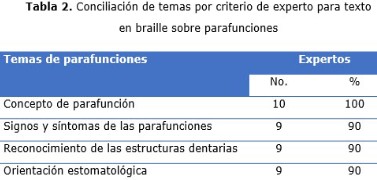Parafunctions text in Braille system for blind and poor vision patients
Abstract
Background: people who have visual problems are not exempted from presenting parafunctional alterations and there are not informative proposals in Braille system that deal with the topic.
Objective: to assess the utility of a parafunction text in Braille system for blind and poor vision patients.
Methods: a quasi-experimental review was conducted from January 2014 and January 2015, by specialists from the Occlusion consultation in the provincial dental clinic “Ismael Clark y Mascaró”. The universe was composed of 1 766 blind and poor vision people. Non probabilistic sample consisted of 476 patients, according to criteria of inclusion. The research was organized into five stages: coordination, search-selection, approval, intervention and evaluation.
Results: before showing the Braille text to blind and poor vision patients, the unsatisfactory level of information was 83.19 %. After being shown satisfactory level prevailed in 98.94 %. The concept of parafunctions was the first aspect to include in the text according to 100 % of experts. The teaching staff who was satisfied accounted for 97.14 %. The utility of the text was demonstrated in 97.68 % of the patients. The text was considered useful according to 97 % of these people.
Conclusions: conceptualization of parafunctions was the first aspect reconciled by all experts. It was agreed the acceptance of the text in Braille system by the majority of teachers dedicated to the teaching of blind and poor vision patients. Great part of the patients with visual handicap found the text useful.
DeCS: EDUCATION OF VISUALLY DISABLED; VISION, LOW; VISUALLY IMPAIRED PERSONS; EPIDEMIOLOGY, EXPERIMENTAL.
Downloads

Published
How to Cite
Issue
Section
License
Copyright: Camagüey Medical Archive Magazine, offers immediately after being indexed in the SciELO Project; Open access to the full text of the articles under the principle of making available and free the research to promote the exchange of global knowledge and contribute to a greater extension, publication, evaluation and extensive use of the articles that can be used without purpose As long as reference is made to the primary source.
Conflicts of interest: authors must declare in a mandatory manner the presence or not of conflicts of interest in relation to the investigation presented.
(Download Statement of potential conflicts of interest)
The Revista Archivo Médico de Camagüey is under a License Creative Commons Attribution-Noncommercial-No Derivative Works 4.0 International (CC BY 4.0).
This license allows others to distribute, to mix, to adjust and to build from its work, even for commercial purposes, as long as it is recognized the authorship of the original creation. This is the most helpful license offered. Recommended for maximum dissemination and use of licensed materials. The full license can be found at: https://creativecommons.org/licenses/












 22 julio 2025
22 julio 2025